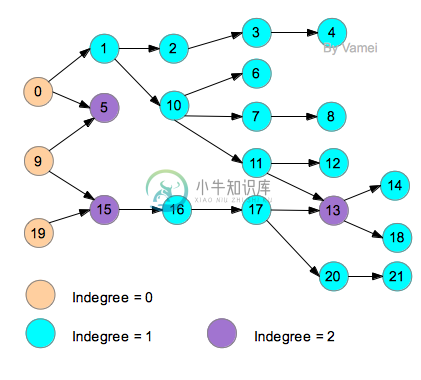纸上谈兵: 拓扑排序
《文明》是一款风靡20多年的回合制策略游戏,由Sid Meier开发。《文明》结构宏大,内容丰富,玩法多样,游戏性强,称得上是历史上最伟大的游戏。在文明中,你可以选择某个文明的,从部落开始发展,在接下来的几千年的历史中,发展科技、开荒拓野、发动战争等等。游戏在保持自由度的前提下,对各个社会文明的发展顺序有很好的仿真性,让玩家仿佛置身于历史长河,坐观文明的起落。美国的一些大学的历史系甚至于使用该游戏作为教学工具。
(作为《文明》的忠实爱好者,多少个昼夜耗费在一张张地图上啊。好吧,是为了学习历史。)
“科技树”

《文明》中的科技树
游戏有一个“科技树”系统,即你可以按照该图所示的顺序来发展科技。“科技树”是这样一个概念: 为了研发某个科技,我们必须已经掌握了该科技的所有前提科技(prerequisite)。科技树中有一些箭头,从A科技指向B科技,那么A就是B的前提科技。比如,根据上面的科技树,为了研发物理(Physics),我们必须已经掌握了化学(Chemistry)和天文学(Astronomy)。而为了研发化学(Chemistry),我们又必须掌握了火药(Gunpowder)。如果一个科技没有其它科技指向,那么就不需要任何前提科技就可以研发,比如图中的封建主义(Feudalism)。如果同一时间只能研发一项科技,那么玩家的科技研发就是一个序列,比如封建主义,工程(Engineering),发明(Invention),火药,一神教(monotheism),骑士制度(Chivalry)…… 有些序列是不合法的,比如工程,发明,火药……,在研发的“发明”时,并没有满足“封建主义”的前提条件。
一个有趣的问题是,如何找到合法的序列呢?当我们在设计计算机玩家时,很可能需要解决这样一个问题。
图(graph)中的拓扑排序算法(Topological Sort)可以给出一个合法序列。虽然在游戏中被称为“科技树”,但“科技树”并不符合数据结构中的树结构。在数据结构中,树的每个节点只能由一个父节点,整个树只有一个根节点。因此,“科技树”是一个不折不扣的图结构。此外,该树是一个有向的无环(acyclic)图。图中不存在环 (cycle, 环是一个长度大于0的路径,其两端为同一节点)。
拓扑排序
拓扑排序利用了一个事实,即在一个无环网络中,有一些节点是没有箭头指入的,比如科技树中的一神教、封建主义、工程。它们可以作为序列的起点。
- 选择没有箭头指入的节点中的任一个,可以作为合法序列的起点,放入序列。
- 当我们将某个节点放入序列后,去掉该节点以及从该节点指出的所有箭头。在新的图中,选择没有箭头指向的节点,作为序列中的下一个点。
- 重复上面的过程,直到所有的节点都被放入序列。
对于每个节点,我们可以使用一个量入度(indegree),用来表示有多少个箭头指入该节点。当某个节点被删除时,图发生变化,我们需要更新图中节点的入度。
为了方便,我将“科技树”中的节点编号,为了符合C语言中的传统,编号从0开始。下面是对应关系:
| 0 | 1 | 2 | 3 | 4 | 5 | 6 | 7 | 8 | 9 |
| 一神教 | 神学 | 印刷术 | 民主 | 自由艺术 | 骑士制度 | 音乐理论 | 银行 | 经济学 | 封建主义 |
| 10 | 11 | 12 | 13 | 14 | 15 | 16 | 17 | 18 | 19 |
| 教育 | 天文学 | 航海术 | 物理 | 重力理论 | 发明 | 火药 | 化学 | 磁学 | 工程 |
| 20 | 21 | ||||||||
| 冶金 | 军事传统 |
我们根据编号,绘制上述图(graph)。我同时用三种颜色,来表示不同点的入度(indegree):

我们使用邻接表的数据结构(参考纸上谈兵: 图),来实现图。构建代码如下:
/* By Vamei */
#include <stdio.h>
#include <stdlib.h>
#define NUM_V 22
typedef struct node *position;
/* node */
struct node {
int element;
position next;
};
/*
* operations (stereotype)
*/
void insert_edge(position, int, int);
void print_graph(position graph, int nv);
/* for testing purpose */
void main()
{
struct node graph[NUM_V];
int i;
// initialize the vertices
for(i=0; i<NUM_V; i++) {
(graph+i)->element = i;
(graph+i)->next = NULL;
}
// insert edges
insert_edge(graph,0,1);
insert_edge(graph,0,5);
insert_edge(graph,1,2);
insert_edge(graph,1,10);
insert_edge(graph,2,3);
insert_edge(graph,3,4);
insert_edge(graph,7,8);
insert_edge(graph,9,5);
insert_edge(graph,9,15);
insert_edge(graph,10,6);
insert_edge(graph,10,7);
insert_edge(graph,10,11);
insert_edge(graph,11,12);
insert_edge(graph,11,13);
insert_edge(graph,13,14);
insert_edge(graph,13,18);
insert_edge(graph,15,16);
insert_edge(graph,16,17);
insert_edge(graph,17,13);
insert_edge(graph,17,20);
insert_edge(graph,19,15);
insert_edge(graph,20,21);
print_graph(graph,NUM_V);
}
/* print the graph */
void print_graph(position graph, int nv) {
int i;
position p;
for(i=0; i<nv; i++) {
p = (graph + i)->next;
printf("From %3d: ", i);
while(p != NULL) {
printf("%d->%d; ", i, p->element);
p = p->next;
}
printf("\n");
}
}
/*
* insert an edge
*/
void insert_edge(position graph,int from, int to)
{
position np;
position nodeAddr;
np = graph + from;
nodeAddr = (position) malloc(sizeof(struct node));
nodeAddr->element = to;
nodeAddr->next = np->next;
np->next = nodeAddr;
}我们可以根据上面建立的图,来获得各个节点的入度。使用一个数组indeg来储存各个节点的入度,即indeg[i] = indgree of ith node。下面的init_indeg()用于初始化各节点的入度:
// according to the graph, initialize the indegree at each vertice
void init_indeg(position graph, int nv, int indeg[]) {
int i;
position p;
// initialize
for(i=0; i<nv; i++) {
indeg[i] = 0;
}
// assimilate the graph
for(i=0; i<nv; i++) {
p = (graph + i)->next;
while(p != NULL) {
(indeg[p->element])++;
p = p->next;
}
}
}正如我们之前叙述的,我们需要找到入度为0的节点,并将这些节点放入序列。find_next()就是用于寻找下一个入度为0的节点。找到对应节点后,返回该节点,并将该节点的入度更新为-1:
/* find the vertice with 0 indegree*/
int find_next(int indeg[], int nv) {
int next;
int i;
for(i=0; i<nv; i++) {
if(indeg[i] == 0) break;
}
indeg[i] = -1;
return i;
}当我们取出一个节点放入序列时,从该节点出发,指向的节点的入度会减1,我们用update_indeg()表示该操作:
// update indeg when ver is removed
void update_indeg(position graph, int nv, int indeg[], int ver) {
position p;
p = (graph + ver)->next;
while(p != NULL) {
(indeg[p->element])--;
p = p->next;
}
}有了上面的准备,我们可以寻找序列。使用数组seq来记录序列中的节点。下面的get_seq()用于获得拓扑排序序列:
// return the sequence
void get_seq(position graph, int nv, int indeg[], int seq[]){
int i;
int ver;
for(i = 0; i<nv; i++) {
ver = find_next(indeg, nv);
seq[i] = ver;
update_indeg(graph, nv, indeg, ver);
}
}
综合上面的叙述,我们可以使用下面代码,来实现拓扑排序:


/* By Vamei */
#include <stdio.h>
#include <stdlib.h>
#define NUM_V 22
typedef struct node *position;
/* node */
struct node {
int element;
position next;
};
/*
* operations (stereotype)
*/
void insert_edge(position, int, int);
void print_graph(position, int);
void init_indeg(position, int , int *);
void update_indeg(position, int, int *, int);
void get_seq(position, int, int *, int *);
int find_next(int *, int);
/* for testing purpose */
void main()
{
struct node graph[NUM_V];
int indeg[NUM_V];
int seq[NUM_V];
int i;
// initialize the graph
for(i=0; i<NUM_V; i++) {
(graph+i)->element = i;
(graph+i)->next = NULL;
}
insert_edge(graph,0,1);
insert_edge(graph,0,5);
insert_edge(graph,1,2);
insert_edge(graph,1,10);
insert_edge(graph,2,3);
insert_edge(graph,3,4);
insert_edge(graph,7,8);
insert_edge(graph,9,5);
insert_edge(graph,9,15);
insert_edge(graph,10,6);
insert_edge(graph,10,7);
insert_edge(graph,10,11);
insert_edge(graph,11,12);
insert_edge(graph,11,13);
insert_edge(graph,13,14);
insert_edge(graph,13,18);
insert_edge(graph,15,16);
insert_edge(graph,16,17);
insert_edge(graph,17,13);
insert_edge(graph,17,20);
insert_edge(graph,19,15);
insert_edge(graph,20,21);
print_graph(graph,NUM_V);
init_indeg(graph,NUM_V,indeg);
get_seq(graph, NUM_V, indeg, seq);
for (i=0; i<NUM_V; i++) {
printf("%d,", seq[i]);
}
}
void print_graph(position graph, int nv) {
int i;
position p;
for(i=0; i<nv; i++) {
p = (graph + i)->next;
printf("From %3d: ", i);
while(p != NULL) {
printf("%d->%d; ", i, p->element);
p = p->next;
}
printf("\n");
}
}
/*
* insert an edge
*/
void insert_edge(position graph,int from, int to)
{
position np;
position nodeAddr;
np = graph + from;
nodeAddr = (position) malloc(sizeof(struct node));
nodeAddr->element = to;
nodeAddr->next = np->next;
np->next = nodeAddr;
}
void init_indeg(position graph, int nv, int indeg[]) {
int i;
position p;
// initialize
for(i=0; i<nv; i++) {
indeg[i] = 0;
}
// update
for(i=0; i<nv; i++) {
p = (graph + i)->next;
while(p != NULL) {
(indeg[p->element])++;
p = p->next;
}
}
}
// update indeg when ver is removed
void update_indeg(position graph, int nv, int indeg[], int ver) {
position p;
p = (graph + ver)->next;
while(p != NULL) {
(indeg[p->element])--;
p = p->next;
}
}
/* find the vertice with 0 indegree*/
int find_next(int indeg[], int nv) {
int next;
int i;
for(i=0; i<nv; i++) {
if(indeg[i] == 0) break;
}
indeg[i] = -1;
return i;
}
// return the sequence
void get_seq(position graph, int nv, int indeg[], int seq[]){
int i;
int ver;
for(i = 0; i<nv; i++) {
ver = find_next(indeg, nv);
seq[i] = ver;
update_indeg(graph, nv, indeg, ver);
}
}View Code上面算法中有一个遍历所有节点的for循环,而循环中的find_next()函数也会遍历所有的节点。因此,算法复杂度为[$O(|V|^2)$]。
在find_next()中,我们将放入序列的节点入度记为-1。find_next()每次会遍历所有的节点,没有必要遍历入度为-1的节点。为了改善算法复杂度,我们可以使用一个队列(或者栈)来记录入度为0的元素。我们每次从队列中取出一个元素放入拓扑序列,并更新相邻元素的入度。如果该元素的相邻元素的入度变为0,那么将它们放入队列中。可以证明,这样的改造后,算法复杂度为[$O(|V|+|E|)$]
问题拓展
通过上面的算法,我们可以获得一个合法的科技发展序列。我随后想到一个问题,如何输出所有的科技发展序列呢?
这个问题的关键在于,某个时刻,可能同时有多个节点的入度同时为0。它们中的任何一个都可以成为下一个元素。为此,我们需要记录所有的可能性。
(我想到的,是复制入度数组和序列数组,以储存不同的可能性。不知道大家有什么更好的想法呢?)
总结
图,拓扑排序

